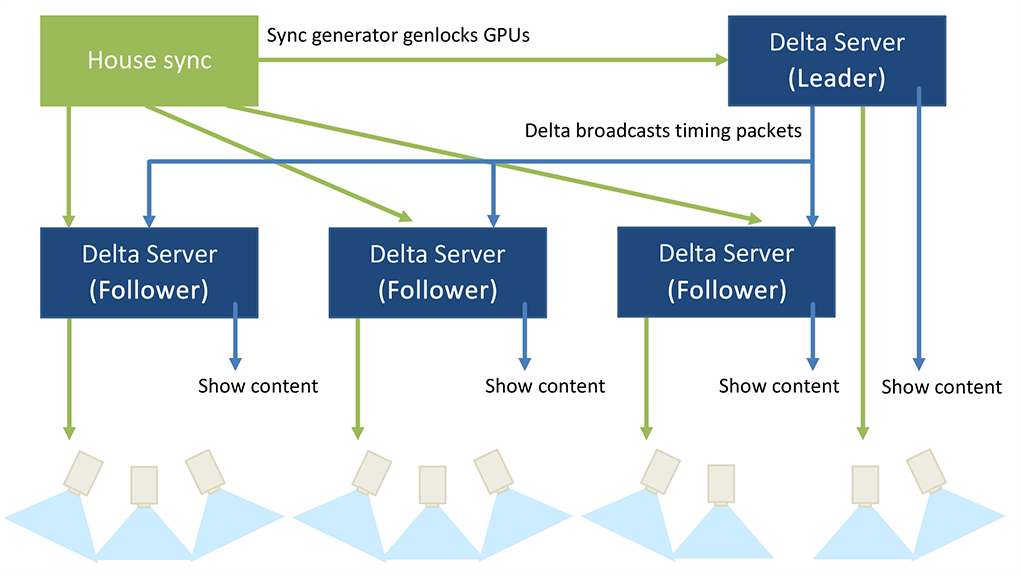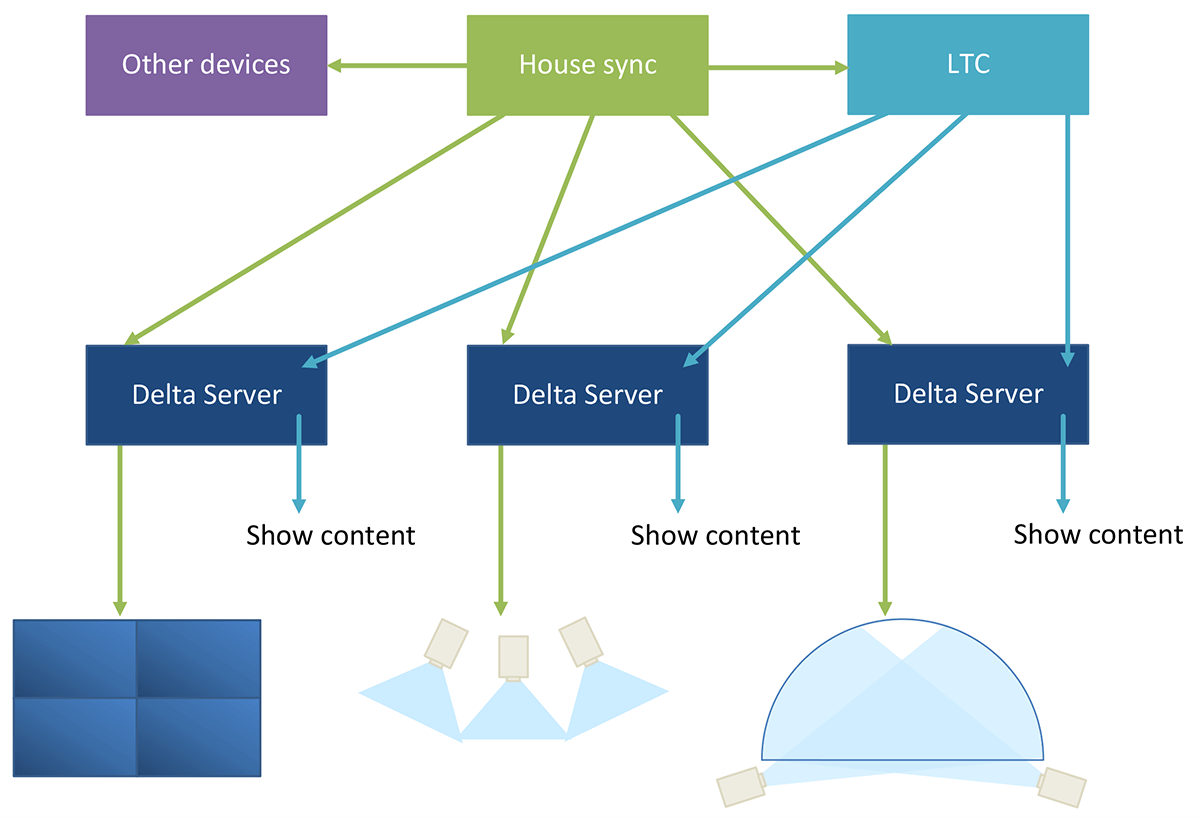Sync Generators
DeltaServer syncs its frame playback to the server GPU clock (in ‘Auto’ or ‘Hardware Timed’ modes), and each GPU can be synced in turn to a central house sync clock. Such sync pulse generators and word clocks do not convey data, only a highly accurate bit-rate as a common timing (not time) reference. Sync pulse generators are used for graphics display synchronisation, whereas word clocks are the standard for synchronising audio devices. Some audio devices have their own internal word clock.
LTC sources
Linear timecode (LTC) provides much more. Whilst the LTC signal is digital in structure, the transmission is traditionally analogue – typically as a .wav audio file with a bit-stream rate of around 1 kHz to 2.5 kHz, in order to be safely within audio range. This is encoded with the required framerate, sample rate, bit depth and duration, to the SMPTE 12M specification. The data block for each frame has 80 bits. These include 26 bits to carry the SMPTE time, and 32 that can carry optional user data (for example, relating to the media for which it is intended). The final 16 bits of the block comprise a fixed bit-pattern ‘sync word’ that an LTC reader uses to define the frame boundary, play direction, and bit-rate of the sync tone.
Delta Leader-Follower Timing
Synchronisation between media players, media resources, display, effects and projection equipment can be fairly complex, and real clock time is not used. However, agreement on the duration of a second, and relative time position do matter. Timestamp markers running through media resources provide all the reference needed for the Delta timeline, which in turn can broadcast the timeline playhead position. Another Delta server receives that position, and its playhead takes the same position on its timeline (i.e. ‘play this same frame no. now’). A Delta Follower server playhead will then always be in the same position as the Leader it is listening to, and will be frame-accurate to ±1 frame when no genlock is present, or frame-accurate with genlock. The downside is that if the Leader server fails, timeline reference is lost across all servers and the show will stop. Here a Delta Leader and three Followers are timeline synchronised, taking their clock reference from the Leader server GPU, and all GPUs and displays are house-synced:
Chasing LTC
Multiple Delta servers that are not Leader-Follower related, or are in different Leader-Follower timing groups, and systems incorporating other devices, or control desks, will need more than a Delta timeline timing packet, so instead we can use a common timing source of linear timecode (LTC), in an audio stream.
This could be played as an audio track on one Delta server, but it must be accommodated within the specification of the server providing the LTC stream, since it requires media storage capacity, bandwidth, and an audio channel. One audio channel of this server is assigned to LTC output, and this channel can be played through an alternative audio device (typically motherboard ASIO audio), with the show audio output running a more professional quality device. This prevents cross-talk and accidental playing of the LTC as show media. The arrangement expands the synchronisation possibilities, but the system as a whole is still vulnerable to dependency on the one server. An LTC-chasing server similarly requires a separate ASIO LTC audio input, which must be accommodated in the server specification if it also requires audio output.
An alternative solution is to take the LTC source from a generator app, or use a purpose-made audio track, played on a dedicated server, connected by direct audio input, or SMPTE device such as Adrielec, or an SDI card.
By switching Delta timelines to listen to this LTC source instead of Leader server timing packets, their playheads will track the position dictated by the LTC source (their new ‘Leader’). Set the LTC to run, and the Delta LTC-chasing playheads follow with a configurable pre-roll time. Delta has an LTC reader (LTCReader) that converts the analogue audio signal into digital format SMPTE code, and which free-runs for a number of frames to cover any transient loss from the TLC source. (An Adrielec or similar card will do the same thing as the LTC reader.)
What this does not do, is synchronise a non-Delta LTC player with any other device. So if an LTC source is used that is not genlocked, then the LTC player system clock will inevitably drift from that of the Delta server(s). Over shorter play durations this should not matter, but for longer shows, the drift more will eventually become apparent.
Genlocking
Frame synchronisation, therefore, may not be enough. The many independent clock devices in items of digital equipment, accurate as they may be, can disagree about the precise length of a unit of time, and drift apart. However, by giving them all the same ‘pacemaker’, in the form of genlocking, they can all be kept in precise clock sync.
In this diagram, all the hardware systems are genlocked, and all servers are playing in sync with a common LTC, which is itself genlocked.
Note that display devices also carry different degrees of latency, and this will depend also on how much internal processing they have.
Page edited [d/m/y]: 15/09/2023

